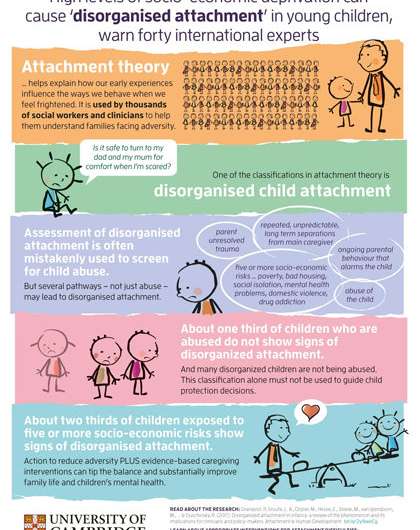Experts express concerns over infant mental health assessment

Forty world experts on child development and mental health have released a joint statement calling for caution when applying an influential classification for assessing infant mental health and potential cases of abuse.
The consensus statement, published in the journal Attachment & Human Development, highlights the appropriate use and current limitations of a classification known as "Disorganised Infant Attachment," which has been in use for over 30 years. The statement has been led by Professor Pehr Granqvist from Stockholm University and Dr Robbie Duschinsky from the University of Cambridge. Among the authors of the consensus statement are the originators of the classification, Mary Main and Judith Solomon. The classification is based on the 'attachment theory' proposed by renowned psychologist John Bowlby in 1969.
Bowlby emphasised that when infants get upset, they tend to turn to their familiar caregivers (usually their parents). However, attachment theory suggests that an infant who has been exposed to 'alarming behaviour' by their caregiver will experience conflict about whether or not it is safe to turn to the caregiver for comfort. One kind of alarming behaviour by a caregiver is abuse of the child.
However, other behaviours can also cause such conflict. For example, the authors point to a meta-analytic study in 2010 by Chantal Cyr (University of Quebec, Montreal) and colleagues at the University of Leiden, which found that when families had five or more socioeconomic risk factors – such as living in poverty, drug addiction, or not graduating from high school – then rates of Disorganised Infant Attachment were comparable to those in families where there is known to be abuse. This is understood to be because adults in such circumstances can exhibit alarming behaviours such as withdrawal from interacting with the child, or frightened behaviours as they interact with the child while also thinking about the dangers and adversity they face in their lives.
A classification of Disorganised Infant Attachment is assigned when an infant aged 12-20 months demonstrates certain behaviours during a so-called "Strange Situation," where the care-giver departs the room, leaving the baby with a stranger – potentially upsetting the infant – before returning. The assessor looks for behaviours suggesting conflict about going to the caregiver for comfort; for instance, if on reunion with the caregiver, an infant falls to the floor, looking disoriented.
There has been a growth in recent years of social workers and clinicians using assessment of disorganised attachment to screen for child abuse. However, the consensus statement argues that this is a misapplication.
Not all abused children receive a disorganised attachment classification, so some abused infants will be missed if this assessment is relied upon alone; and many non-abused children do receive a disorganised classification, as a variety of alarming caregiver behaviours can predispose conflict behaviours, not just abuse.
"There are all kinds of things that might make a child alarmed by his or her care-giver," says Dr Duschinsky from the Department of Public Health and Primary Care at Cambridge, one of the lead authors of the statement. "While the Disorganised Infant Attachment classification does offer some general indications regarding the history and future mental health of the child, it is much too blunt an instrument to be used for child protection assessment."
The consensus statement suggests that while the Disorganised Infant Attachment classification has its limitations, it can still be useful when used as part of a battery of tests, but it should not be relied on its own. The authors also conclude that the real practical utility of attachment theory and research resides in supporting understanding of families and in providing evidence-based, supportive interventions. Rather than press the disorganised classification as it stands inappropriately into service for child protection assessments, the consensus statement states that further work is a priority to see whether the classification can be further specified and validated for this purpose.
Dr Duschinsky's own research – including a second paper published this month – has drawn upon John Bowlby's historical archive at the Wellcome Library, London. This work fed directly into the consensus statement providing greater conceptual clarity about the nature of infant conflict behaviour. "It is unusual for historical work to feed into modern practice guidelines," he says, "but my work shows that Bowlby's ideas is still of relevance today."
More information: Pehr Granqvist et al. Disorganized attachment in infancy: a review of the phenomenon and its implications for clinicians and policy-makers, Attachment & Human Development (2017). DOI: 10.1080/14616734.2017.1354040
Judith Solomon et al. Toward an architecture of attachment disorganization: John Bowlby's published and unpublished reflections, Clinical Child Psychology and Psychiatry (2017). DOI: 10.1177/1359104517721959

















